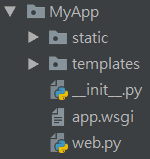Flask deploy into Apache on CentOS
Environment
- CentOS Linux release 7.5.1804 (Core)
- httpd 2.4.6 (Apache)
- mod_wsgi 4.6.4
- Python 3.5.1
Project Structure

- log: sotre apache log such as error log and access log
- static: sotre static file such as image, css, js
- templates: store html file
- web.py
from flask import Flask
app = Flask(__name__)
@app.route("/")
def hello():
return "Hello world!"
- app.wsgi
from web import app as application
Deployment Process
Install Python3.5
Enable Software Collections (SCL)
$ yum install centos-release-scl
Install Python3
$ yum install rh-python35
Check Python Version
$ python --version
Python 2.7.5
Set Python3 as Default
$ scl enable rh-python35 bash
# If you want to always set python3 as default, add the above command line in .bash_profile.
Check Python Version Again
$ python --version
Python 3.5.1
Install gcc compiler, for installing Python modules.
$ yum install gcc
$ yum install gcc-c++
Creating a Virtual Environment
Switch to the path where you want to create a virtual environment.
$ cd your_venv_path
Create a virtual environment
$ python -m venv venv_name
Activate the virtual environment
$ source venv_name/bin/activate
After activating the environment
(venv_name) user@host$
Install Apache
Inatall apache
$ yum install httpd
Install mod_wsgi
Inatall apache related package for the pip installation of mod_wsgi to work.
$ yum install httpd-devel
Install mod_wsgi for Python3
$ pip install mod_wsgi
Check wsgi_module path
$ mod_wsgi-express install-module
LoadModule wsgi_module "/usr/lib64/httpd/modules/mod_wsgi-py35.cpython-35m-x86_64-linux-gnu.so"
Add above full LoadModule command line in apache load module config.
First, create a 02-wsgi.conf.
$ vim /etc/httpd/conf.modules.d/02-wsgi.conf
Second, add following LoadModule command line in 02-wsgi.conf.
LoadModule wsgi_module "/usr/lib64/httpd/modules/mod_wsgi-py35.cpython-35m-x86_64-linux-gnu.so"
Apache config settings
Create a app.conf file in apache config folder
$ vim /etc/httpd/conf.d/app.conf
And add the following content in app.conf.
# define a variable which is your project path
Define PROJECT_PATH /your_project_path/MyApp
Listen 80
<virtualhost *:80>
# wsgi settings
WSGIDaemonProcess myapp python-path=${PROJECT_PATH}:/root/venv/lib/python3.5/site-packages
WSGIProcessGroup myapp
WSGIScriptAlias / ${PROJECT_PATH}/app.wsgi
# map server side static directory to {ip or domain_name}/static
Alias /static ${PROJECT_PATH}/static
# allow all requests to access this project file
<Directory ${PROJECT_PATH}/>
Require all granted
</Directory>
# set log saved path
ErrorLog ${PROJECT_PATH}/log/error.log
CustomLog ${PROJECT_PATH}/log/access.log combined
</virtualhost>
Start Apache
$ systemctl start httpd
If you encounter startup error, using following command to see startup log.
$ systemctl -l status httpd.service
Reference
- Install Python3 on CentOS7
https://linuxize.com/post/how-to-install-python-3-on-centos-7/ - Install Apache and mod_wsgi
https://www.jianshu.com/p/e3afd572f1be - Install mod_wsgi for Python3
https://stackoverflow.com/questions/47650902/httpd-mod-wsgi-for-python3-4-not-working-in-centos7
Others
User specific environment and startup programs.
- .bashrc: alias settings
- .bash_profile: proxy and other startup settings.
- Activate settings
$ source .bash_profile